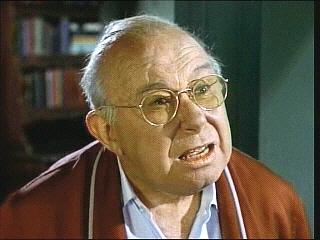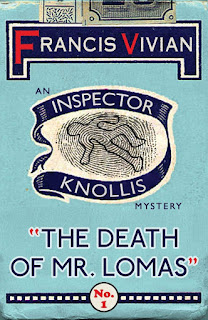There was a
character actor who always got bumped off in movies I watched as a
kid. Soon as I saw him on the screen, as a hotel clerk, a
barkeep--someone who stumbles into a holdup or some other criminal
activity, which was the only kind of role I remember seeing him in, I
knew instantly he was about to get bumped off, as he was never
onscreen long enough to develop any role other than victim. I don't
know his name, but I can see his dumpy little body clearly and hear
the high-pitched, nervous, raspy voice. which reminded me of the Snow
White dwarf "Doc," begging desperately not to get bumped
off. I've Googled until my fingers screamed, trying every which way
to identify this putz, to no avail. I may even have added "born
with bump
me off
tattooed on his butt" to my Googling. You'd think someone at
Google would have felt a little compassion for me, steered me in the
right direction. But...
If The
Death of Mr. Lomas
had been made into a movie back in the day (the book was published in
1941) guess who would have played Mr. Lomas? I'll let author Francis
Vivian give you a clue—the first paragraph of the prologue:
He was a
little old man with shrewd grey eyes. He had a yellowish goatee
beard, a moustache with waxed points, and bushy eyebrows. His
nostrils were twitching and his lips quavering when he called on the
Chief Constable of Burnham early that fine June morning. He allowed
himself no more than the front edge of the chair with which he was
provided and each time his eyes met those of the Chief Constable they
retreated behind
their
lids like the horns of a snail.
A little
later, still in the chief constable's office, the little old man
comes to the point:
"Mr. Lomas wriggled on his inch of chair. His beard quavered
ridiculously as he tried to force words from his throat. He opened
his mouth twice, only to close it again...[and] eventually gripped
the arms of the chair and leaned forward. 'I am being poisoned, Sir
Wilfred!' he said dramatically." Sir Wilfred, of course, thinks
him a kook, and dismisses him,
But later
that day...oh yes...Mr. Lomas indeed turns up dead. His beard had
been shaved off postmortem. Tests soon establish fatal
cocaine poisoning.
It's
probably a good thing this observation by local police Inspector
Gordon Knollis didn't appear until chapter eleven or one might have
wondered by then if the honorable protagonist of Vivian's ten
Inspector Knollis cases was in fact quite so honorable, or was at
best full of baloney:
"...this is no story-book case, and there will be no surprise
ending. The most obvious person killed him, for the commonest and
most obvious reason. That person went about it in the simplest
possible way, and, paradoxically, it
is the factor of simplicity that has proved the complication in the
case.”
Well,
maybe in Knollis's mind. In my mind that statement, especially by
chapter eleven, is laughable. A veritable horde of suspects emerged
almost immediately after Mr. Lomas's OD. Among them are his dentist
son and spinster daughter, who stand to inherit a sizable cash
estate, a pharmacist "best friend" who loved Lomas's
mistreated wife (who died recently), the son's mysterious girlfriend,
and assorted other vaguely sinister characters. Complementing these
suspects
with their motives, means, and personalities was the early discovery
Lomas had been a prickly, miserly SOB more akin to the fairytale
troll under the bridge than the lovable Dwarf Doc impression I'd
somehow conjured at the start. And despite Knollis's denial of
complications, this, with its multitude of secretive, potential
poisoners,
was one of the most complicated crime novels I've ever read. It took
Knollis, with his assistants, to probe and unravel and theorize and
analyze and puzzle the pieces together to...well let's let him
explain:
"I
always wanted to be an engineer," he tells his wife, "to
take things to pieces and put them together again; I always wanted to
know how things work, and why they work.”
She smiled,
the loyal wife boosting her hubby's self-confidence. “Doesn’t
that prove that you have a flair for detection? You deal with men’s
minds, motives, and desires. You dissect their actions, theorize on
why they do this, and that, and the other; on how they could have
done this, and that, and the other. You are just as much an engineer
as if you were dealing with engines and machinery.”
She allows
a little humor into the mood by telling him, “you
look like a detective.”
This
revelation was most welcome with me, as my introduction to the
Knollis series had been book six, The
Singing Masons,
in which he's now with Scotland Yard and is assigned to aid local
constables stuck with a most unusual murder among several beekeepers
and their families. The
Death of Mr. Lomas
is the series debut, providing us an introduction to its star.
Knollis,
the author tells us, "looked more like a detective than anything
Hollywood could produce in its most enthusiastic moments. He might
have been taken from stock. He was lean, and had a long inquisitive
nose that was destined to be thrust into mysteries whether mechanical
or psychological. His eyes were of a cold grey hue, mere slits
through which he regarded the world with suspicion. They were
forbidding until the creases at the corners were noticed, but it was
seldom they came into play unless he was relaxing in his wife’s
company or playing bears with the two infant versions of himself who
were now safely tucked up in the nursery above them. Knollis’s
major trait was patience, a fact thoroughly appreciated both by his
wife and by the officers with whom he worked;
it was his patience that had enabled him to rise from a uniformed
constable on beat to the head of the Burnham Criminal Investigation
Department. He was now forty-one years of age, and eminently
satisfied with his lot."
So there. Sort of a
modernized, domesticized version of Sherlock Holmes. Basil Rathbone
would have been perfect.
There
are some disturbing, as well as eye-rolling moments in the narrative
attributable presumably
to
the WWII-era majority public sensibility.
We have curtains described as nigger-brown,
and physical features suggesting moral turpitude, such as the
description of Lomas's dentist son as “clear-eyed and
fresh-complexioned. His jaw was tight, but Knollis, from long
experience, recognized signs of moral weakness in the curve of the
chin and the sloping angle of the jaw.” Gotta wonder how many male
readers reflexively reached for their own jaws after reading that
line. Alas
I,
of impeccably
adequate
moral strength, succumbed, as
well,
dammit.
This one still holds, tho, I
submit: “I cannot understand the ramifications of the female
mind.”
Vivian
leaves us with one mystery unsolved. Perhaps more can be learned in
later episodes:
Knollis
calls his typewriter “George.”
This
just in:
My
friends at Google evidently have been reading over my shoulder, as
they just now have surprised me with a gift! The guy from whom I
learned as a young, impressionable moviegoer never to beg murderers
for mercy was Mr. Percy Helton. May he rest in peace at long, long
last.
[For
more Friday's Forgotten Books check the links on Patti
Abbott's unforgettable blog]


Mathew – You nailed it. Percy Helton matches your description. He was in a ton of movies and TV shows. Check out his IMDb page:
ReplyDeletehttps://www.imdb.com/name/nm0375887/?ref_=ttfc_fc_cl_t3
Good idea. Thanks, Elgin!
DeleteMerry X'Mas and a Happy New Year to you and your loved ones, Mathew.
ReplyDeleteMany thanks, Neeru, and may you and yours enjoy the season, as well!
Delete